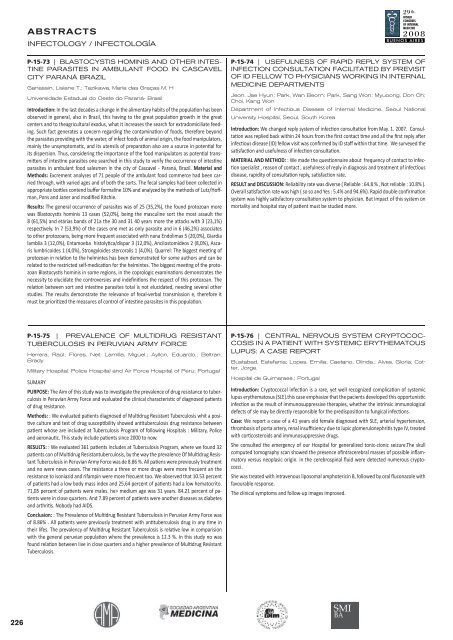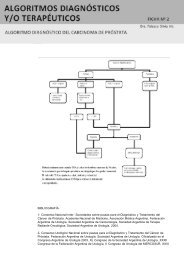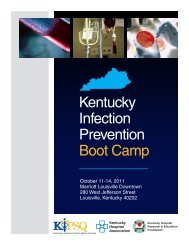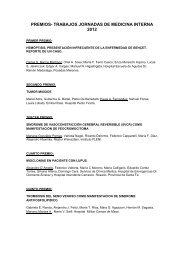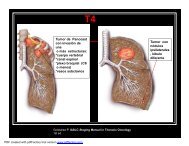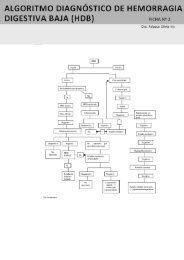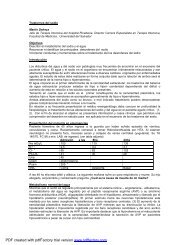You also want an ePaper? Increase the reach of your titles
YUMPU automatically turns print PDFs into web optimized ePapers that Google loves.
226<br />
ABSTRACTS<br />
INFECTOLOGY / INFECTOLOGÍA<br />
P-15-73 | BLASTOCYSTIS HOMINIS AND OTHER INTES-<br />
TINE PARASITES IN AMBULANT FOOD IN CASCAVEL<br />
CITY PARANÁ BRAZIL<br />
Ganassin, Lisiane T.; Tazikawa, María das Graças M. H<br />
Universidade Estadual do Oeste do Paraná- Brasil<br />
Introduction: In the last decades a change in the alimentary habits of the population has been<br />
observed in general, also in Brazil, this having to the great population growth in the great<br />
centers and to theagricultural exodus, what it increases the search for extradomiciliate feeding.<br />
Such fact generates a concern regarding the contamination of foods, therefore beyond<br />
the parasites providing with the water, of infect foods of animal origin, the food manipulators,<br />
mainly the unsymptomatic, and its utensils of preparation also are a source in potential for<br />
its dispersion. Thus, considering the importance of the food manipulators as potential transmitters<br />
of intestine parasites one searched in this study to verify the occurrence of intestine<br />
parasites in ambulant food salesmen in the city of Cascavel - Paraná, Brazil. Material and<br />
Methods: Excrement analyses of 71 people of the ambulant food commerce had been carried<br />
through, with varied ages and of both the sorts. The fecal samples had been collected in<br />
appropriate bottles contend buffer formaline 10% and analyzed by the methods of Lutz/Hoffman,<br />
Pons and Janer and modified Ritchie.<br />
Results: The general occurrence of parasites was of 25 (35,2%), the found protozoan more<br />
was Blastocystis hominis 13 cases (52,0%), being the masculine sort the most assault the<br />
8 (61,5%) and etárias bands of 21a the 30 and 31 40 years more the attacks with 3 (23,1%)<br />
respectively. In 7 (53,9%) of the cases one met as only parasite and in 6 (46,2%) associates<br />
to other protozoans, being more frequent associated with nana Endolimax 5 (20,0%), Giardia<br />
lamblia 3 (12,0%), Entamoeba histolytica/dispar 3 (12,0%), Ancilostomídeos 2 (8,0%), Ascaris<br />
lumbricoides 1 (4,0%), Strongyloides stercoralis 1 (4,0%). Quarrel: The biggest meeting of<br />
protozoan in relation to the helmintes has been demonstrated for some authors and can be<br />
related to the restricted self-medication for the helmintes. The biggest meeting of the protozoan<br />
Blastocystis hominis in some regions, in the coprologic examinations demonstrates the<br />
necessity to elucidate the controversies and indefinitions the respect of this protozoan. The<br />
relation between sort and intestine parasites total is not elucidated, needing several other<br />
studies. The results demonstrate the relevance of fecal-verbal transmission e, therefore it<br />
must be prioritized the measures of control of intestine parasites in this population.<br />
P-15-75 | PREVALENCE OF MULTIDRUG RESISTANT<br />
TUBERCULOSIS IN PERUVIAN ARMY FORCE<br />
Herrera, Raúl; Flores, Neil; Lamilla, Miguel.; Ayllon, Eduardo.; Beltran,<br />
Brady.<br />
Military Hospital, Police Hospital and Air Force Hospital of Peru; Portugal<br />
SUMARY<br />
PURPOSE: The Aim of this study was to investigate the prevalence of drug resistance to tuberculosis<br />
in Peruvian Army Force and evaluated the clinical characteristic of diagnosed patients<br />
of drug resistance.<br />
Methods: : We evaluated patients diagnosed of Multidrug Resistant Tuberculosis whit a positive<br />
culture and test of drug susceptibility showed antituberculosis drug resistance between<br />
patient whose are included at Tuberculosis Program of following Hospitals : Military, Police<br />
and aeronautic. This study include patients since 2000 to now.<br />
RESULTS: : We evaluated 361 patients includes at Tuberculosis Program, where we found 32<br />
patients con of Multidrug Resistantuberculosis, by the way the prevalence Of Multidrug Resistant<br />
Tuberculosis in Peruvian Army Force was de 8.86 %. All patiens were previously treatment<br />
and no were news cases. The resistance a three or more drugs were more frecuent an the<br />
resistance to isoniazid and rifampin were more frecuent too. We observed that 10.53 percent<br />
of patients had a low body mass index and 25,64 percent of patients had a low hematocrito.<br />
71,05 percent of patients were males. he> medium age was 31 years. 84.21 percent of patients<br />
were in close quarters. And 7.89 percent of patients were another diseases as diabetes<br />
and arthritis. Nobody had AIDS.<br />
Conclusion: : The Prevalence of Multidrug Resistant Tuberculosis in Peruvian Army Force was<br />
of 8.86% . All patients were previously treatment with antituberculosis drug in any time in<br />
their lifes. The prevalency of Multidrug Resistant Tuberculosis is relative low in comparision<br />
with the general peruvian population where the prevalence is 12.3 %. In this study no was<br />
found relation between live in close quarters and a higher prevalence of Multidrug Resistant<br />
Tuberculosis.<br />
P-15-74 | USEFULNESS OF RAPID REPLY SYSTEM OF<br />
INFECTION CONSULTATION FACILITATED BY PREVISIT<br />
OF ID FELLOW TO PHYSICIANS WORKING IN INTERNAL<br />
MEDICINE DEPARTMENTS<br />
Jeon, Jae Hyun; Park, Wan Beom; Park, Sang Won; Myuoong, Don Oh;<br />
Choi, Kang Won<br />
Department of Infectious Disease of Internal Medicine, Seoul National<br />
University Hospital, Seoul, South Korea<br />
Introduction: We changed reply system of infection consultation from May. 1. 2007. Consultation<br />
was replied back within 24 hours from the first contact time and all the first reply after<br />
infectious disease (ID) fellow visit was confirmed by ID staff within that time. We surveyed the<br />
satisfaction and usefulness of infection consultation.<br />
MATERIAL AND METHOD: : We made the questionnaire about frequency of contact to infection<br />
specialist , reason of contact , usefulness of reply in diagnosis and treatment of infectious<br />
disease, rapidity of consultation reply, satisfaction rate.<br />
RESULT and DISCUSSION: Reliability rate was diverse ( Reliable : 64.8 % , Not reliable : 10.8% ).<br />
Overall satisfaction rate was high ( so so and Yes : 5.4% and 94.6%). Rapid double confirmation<br />
system was highly satisfactory consultation system to physician. But impact of this system on<br />
mortality and hospital stay of patient must be studied more.<br />
P-15-76 | CENTRAL NERVOUS SYSTEM CRYPTOCOC-<br />
COSIS IN A PATIENT WITH SYSTEMIC ERYTHEMATOUS<br />
LUPUS: A CASE REPORT<br />
Bustabad, Estefania; Lopes, Emilia; Caetano, Olinda.; Alves, Gloria; Cotter,<br />
Jorge.<br />
Hospital de Guimaraes.; Portugal<br />
Introduction: Cryptococcal infection is a rare, yet well recognized complication of systemic<br />
lupus erythematosus (SLE).this case emphasize that the pacients developed this opportunistic<br />
infection as the result of immunosuppressive therapies, whether the intrinsic immunological<br />
defects of sle may be directly responsible for the predisposition to fungical infections.<br />
Case: We report a case of a 41 years old female diagnosed with SLE, arterial hypertension,<br />
thrombosis of porta artery, renal insufficiency due to lupic glomerulonephritis type IV, treated<br />
with corticosteroids and immunosuppressive drugs.<br />
She consulted the emergency of our Hospital for generalized tonic-clonic seizure.The skull<br />
computed tomography scan showed the presence ofintracerebral masses of possible inflammatory<br />
versus neoplasic origin. in the cerebrospinal fluid were detected numerous cryptococci.<br />
She was treated with intravenous liposomal amphotericin B, followed by oral fluconazole with<br />
favourable response.<br />
The clinical symptoms and follow-up images improved.


